The NFSA collection contains over 100 political glass slide advertisements from 1917 to 1976. This selection traces the development of early political cinema advertising.

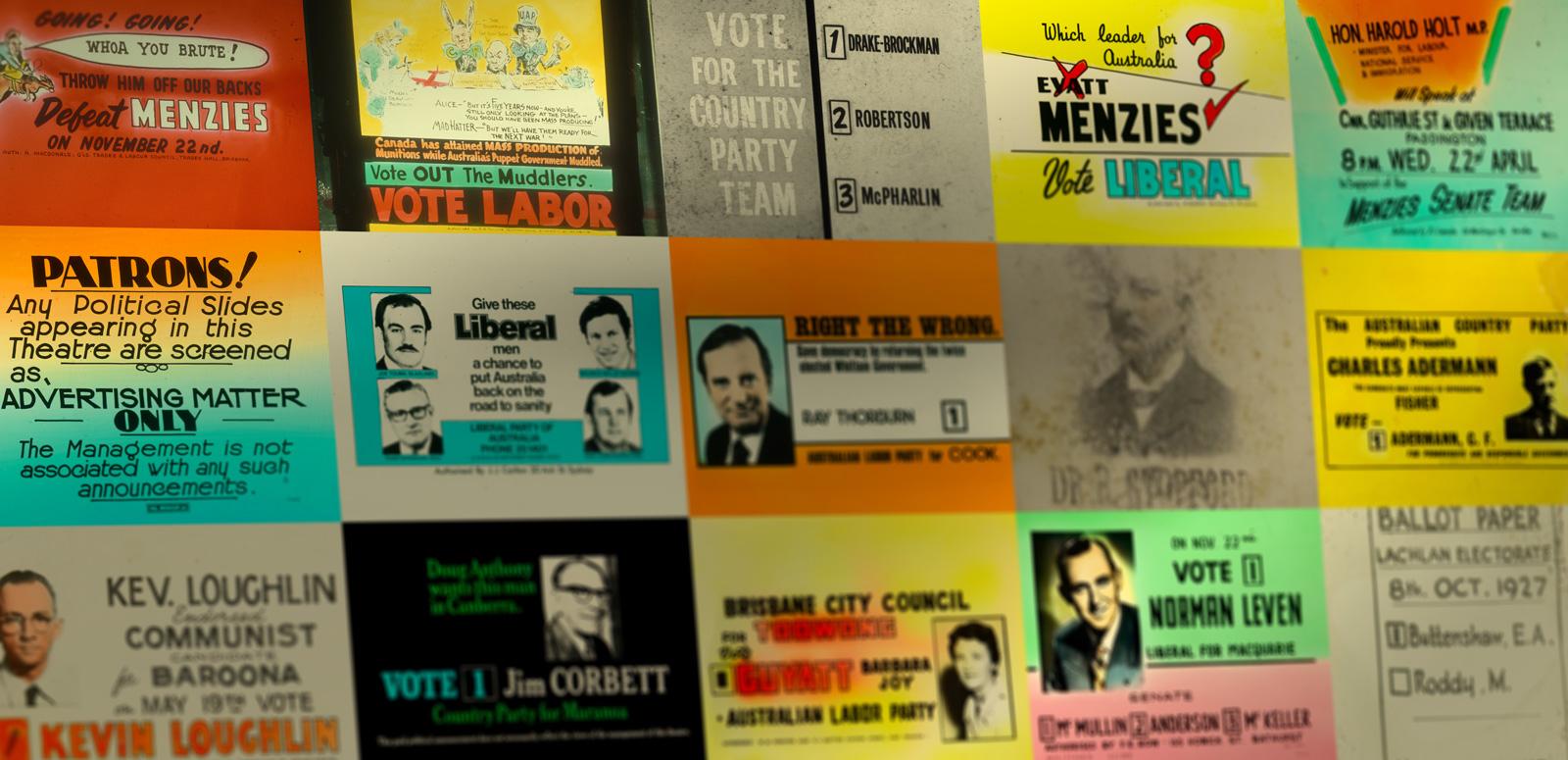
The NFSA collection contains over 100 political glass slide advertisements from 1917 to 1976. This selection traces the development of early political cinema advertising.
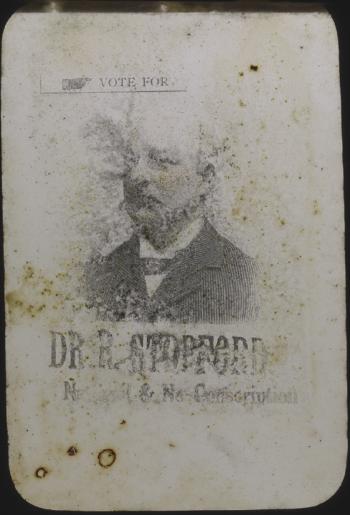
In the early 20th century, political parties discovered a new way to reach a large captive audience of potential voters – the cinema.
Before the start of the advertised feature, political advertisements were projected on the screen using glass slides.They could be produced in-house by cinema owners or outsourced; they could be handwritten (see Gallery 1: slide 1) or professionally printed (see Gallery 1: slide 2).
The earliest political glass cinema slide in the NFSA collection dates to c1917 and is for Nationalist Party member, Dr Robert Stopford (image right). The slide is simple in its approach, with a black-and-white profile of Dr Stopford, and mention of his party and the key issues he stood for. There are no bright colours or slogans to distract. Rather, Dr Stopford relied on his high profile in the community, specifically his humanitarian work promoting child and maternal health, running a clinic for impoverished children and advocating for the introduction of a state medical service.
![Handwritten glass slide showing ballot paper Clear background with black text. Text: 'Ballot Paper Lachlan Electorate 8th Oct. 1927'. Listed names are [1] Buttenshaw, E.A. and Roddy, M Handwritten glass slide showing ballot paper Clear background with black text. Text: 'Ballot Paper Lachlan Electorate 8th Oct. 1927'. Listed names are [1] Buttenshaw, E.A. and Roddy, M](/sites/default/files/styles/teaser_large_768x432/public/05-2019/1499726_0005.jpg?h=a9ce28e1&itok=60zbk1-g)
Vote 1 Buttenshaw, glass slide (1927). NFSA title: 1499726. An example of a simple, handwritten glass slide for Country Party candidate Ernest Buttenshaw.
Slide 1: click on image to view
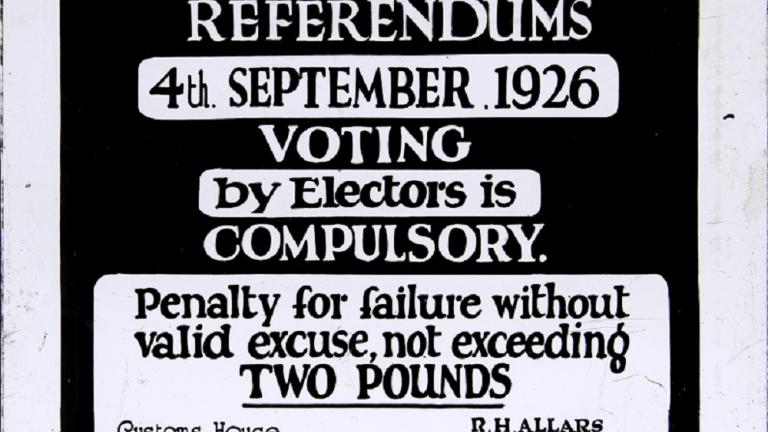
Commonwealth Referendums, glass slide (1926). NFSA title: 1503855. An example of a professionally printed glass slide advertising the newly introduced (in 1924) compulsory voting system.
Slide 2: click on image to view
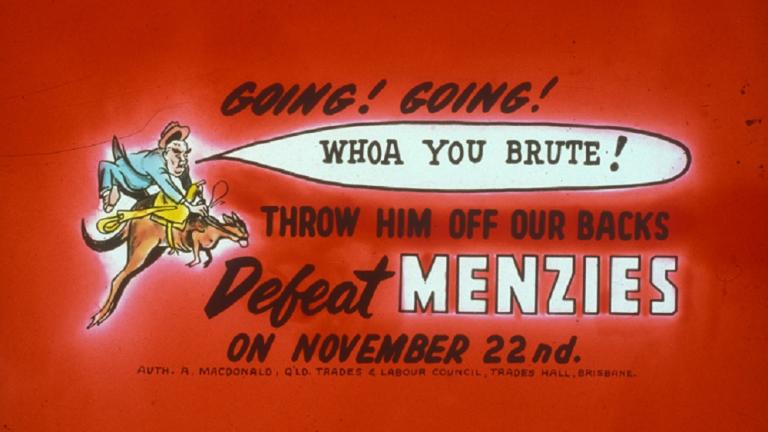
Australian Labor Party, glass slide (1958). NFSA title: 352892
Slide 3: click on image to view
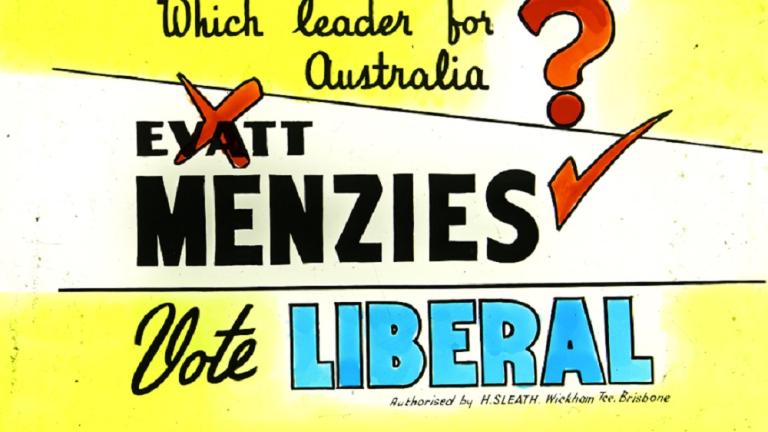
Vote Liberal, glass slide (1955). NFSA title: 356502
Slide 4: click on image to view
Some of the most colourful slides in the collection were produced from the 1940s to the 1950s. For the 1958 federal election campaign, the Labor Party created a striking cartoon (see Gallery 1: slide 3) ridiculing then Prime Minister Robert Menzies, who is depicted riding a kangaroo, a symbol of Australia. The cartoon has a vibrant red Labor background and suggests that Menzies has ‘ridden’ Australia for too long. It contrasts with the slide produced by the Liberal Party (see Gallery 1: slide 4) which features the yellow and blue of the Coalition and promotes Menzies as the ideal leader for Australia and the Labor alternative, HV Evatt, as the inferior option.
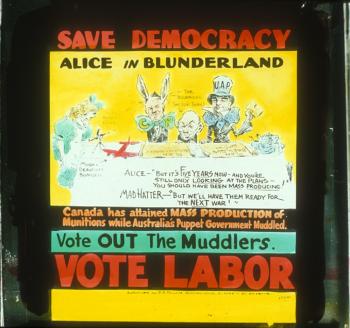
One of the most unusual slides in the collection is this vibrant example used by the Labor Party for the 1940 federal election (image left). Labor's 'Alice in Blunderland' is critical of taxation, corruption and corporate greed. This wartime advertisement depicts: then Prime Minister Menzies as the Mad Hatter, wearing a hat labelled UAP (United Australia Party); Country Party leader Archie Cameron as the Dormouse; and Billy Hughes peeping from behind the table, all looking over manufacturing plans for Bren guns and Beaufort bombers.
Prior to the 1972 federal election political advertising was largely left in the hands of state party divisions and individual candidates.
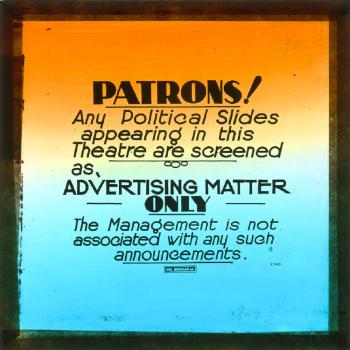
As such there was a diversity of election advertisements, lacking consistency of colours, branding or campaign messages. Even within the same political party, the dissimilarity of slides is sometimes striking (see Gallery 2: slides 1 & 2).
Political party branding did not emerge until the early 1980s and none of the slides in the NFSA collection have the logos we associate with political parties today.
Glass cinema slides had reached their peak by the mid-20th century, however cinema owners were conscious to dissociate themselves from candidates or parties. This slide (image right), with its colourful background and bold text, clearly emphasises the political neutrality of the cinema, distancing them from candidates they felt could potentially affect their business (see also Gallery 2: slide 3).
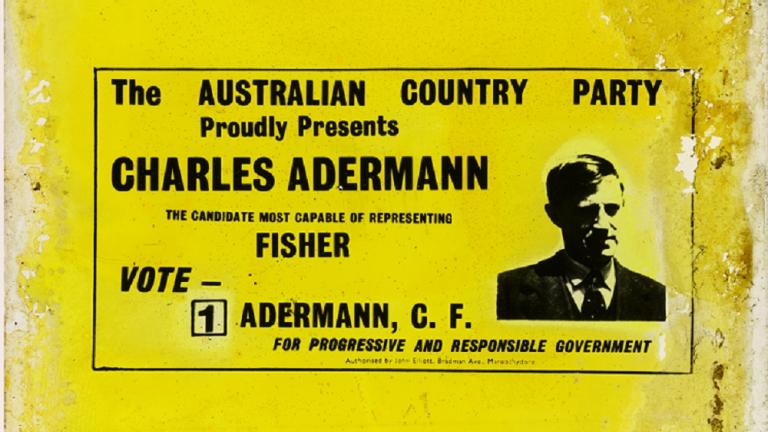
Vote 1: Adermann CF, glass slide (1969). NFSA title: 1126031
Slide 1: click on image to view
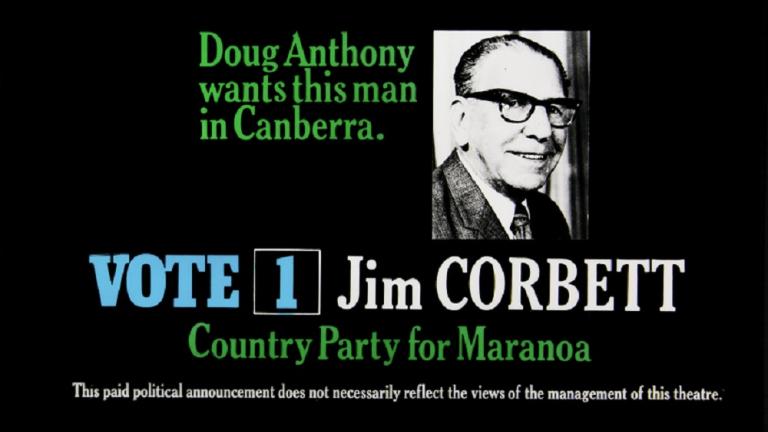
Vote 1: Jim Corbett, glass slide (1972). NFSA title: 1227895
Slide 2: click on image to view
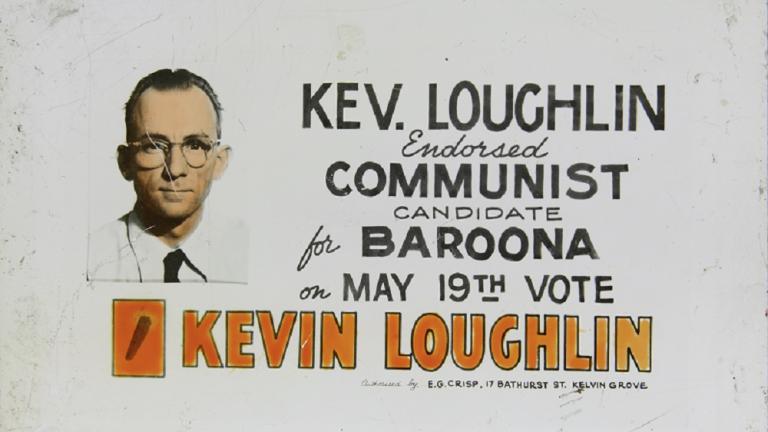
Vote 1: Kevin Loughlin, glass slide (1956). NFSA title: 1499659
Slide 3: click on image to view
![Features image of Norman Leven to the left. Text on the green background reads: 'on Nov 22nd Vote [1] Norman Leven, Liberal for Macquarie'. Other candidates listed. Features image of Norman Leven to the left. Text on the green background reads: 'on Nov 22nd Vote [1] Norman Leven, Liberal for Macquarie'. Other candidates listed.](/sites/default/files/styles/teaser_large_768x432/public/05-2019/1503895_0002.jpg?h=935b69e9&itok=Qo95ee8D)
Vote 1: Norman Leven, glass slide (1958). NFSA title: 1503895
Slide 4: click on image to view
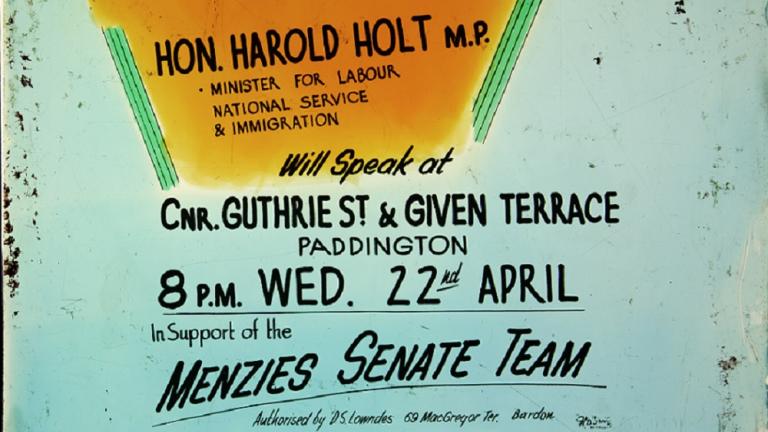
Hon. Harold Holt MP, glass slide (date unknown). NFSA title: 358945
Slide 5: click on image to view
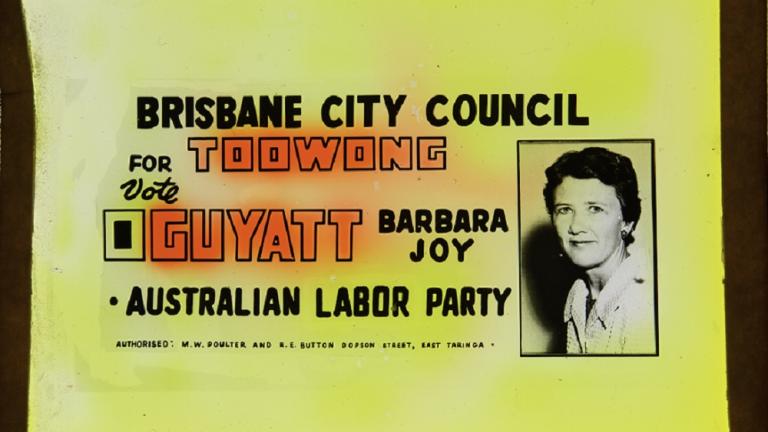
Vote for Guyatt, glass slide (c1955). NFSA title: 1499626
Slide 6: click on image to view
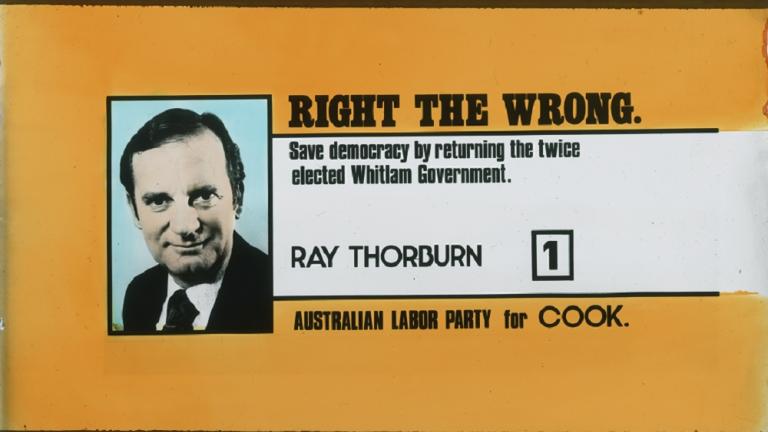
Vote 1: Ray Thornburn, glass slide (1974). NFSA title: 776785
Slide 7: click on image to view
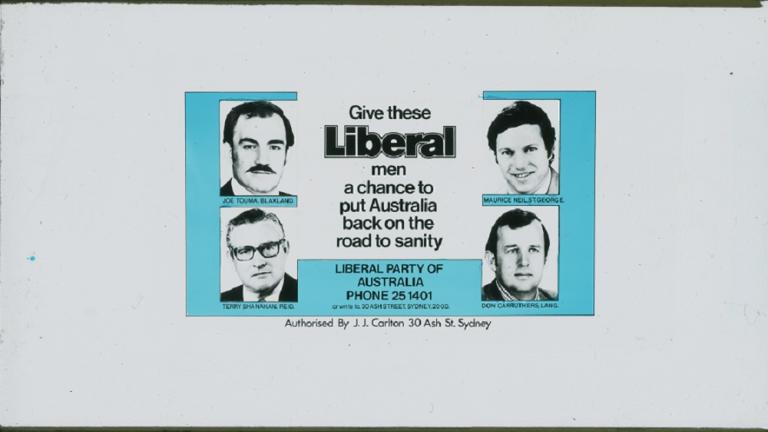
Liberal Party of Australia, glass slide (1975). NFSA title: 778783
Slide 8: click on image to view
These slides also represent contrasting careers in Australian politics, candidates who flourished or floundered. Norman Leven (see Gallery 2: slide 4) was unsuccessful in his attempts to win the seat of Macquarie in both the 1955 and 1958 elections while Harold Holt (see Gallery 2: slide 5) progressed from his role as Minister for Labour, National Service and Immigration to eventually become prime minister.
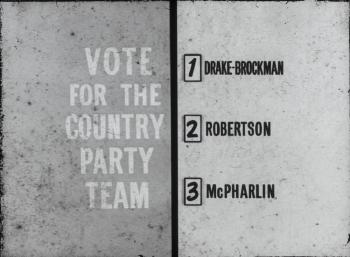
The slides also reveal an untold story, with two slides in the collection advertising female political candidates. At first glance it would be easy to overlook this simple and unassuming slide (image left), however it reveals the story of one of Australia’s earliest female senators, Agnes Robertson. She was the Country Party’s first, and Western Australia’s second, female senator. The second slide (see gallery 2: slide 6) is for Barbara Joy Guyatt who ran for the ward of Toowong in the Brisbane City Council elections.
By the 1970s both major political parties had hired advertising agencies and the glass slides are much slicker in design, with candidate profiles, slogans and distinctive colours. See, for example, the two slides for the 1975 federal election (see gallery 2: slides 7 & 8) that refer to the dismissal of the Whitlam government.
In due course political parties turned away from cinema advertising and focused on television, with its greater capacity to reach a large audience. By the 1970s glass cinema slides had dwindled in number.
Political glass cinema slides are a window into Australia’s political past. They reveal much about our history and our democracy, showing the issues that mattered and how candidates and parties sold themselves to voters.
The National Film and Sound Archive of Australia acknowledges Australia’s Aboriginal and Torres Strait Islander peoples as the Traditional Custodians of the land on which we work and live and gives respect to their Elders both past and present.